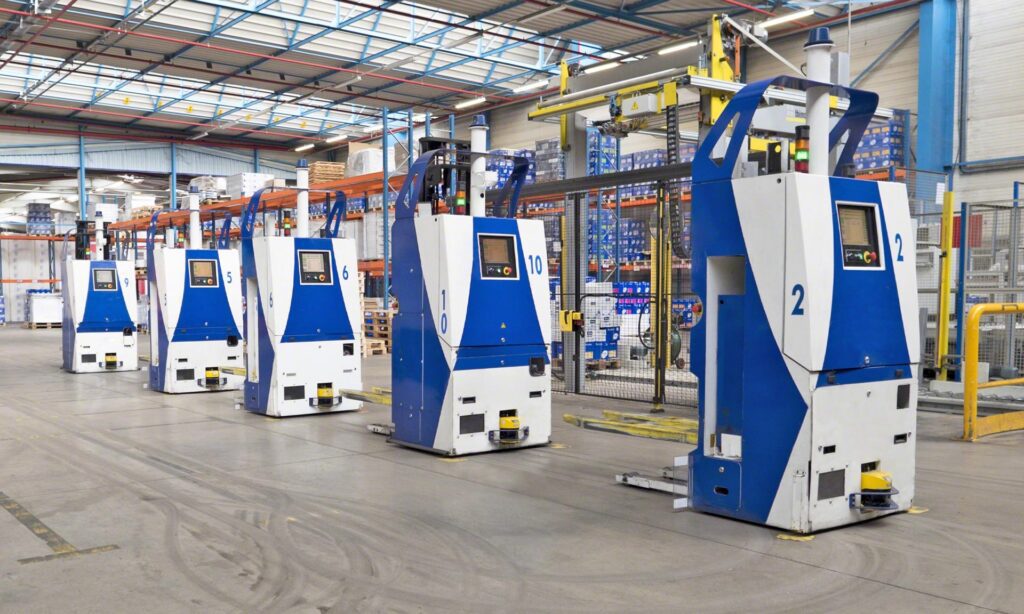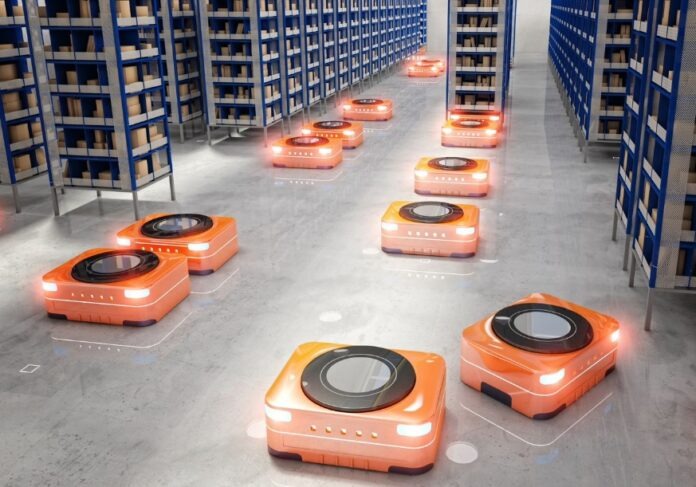1. Introduction
In today’s fast-paced global economy, supply chain efficiency has become a critical factor for business success. With rising consumer expectations for faster deliveries, reduced costs, and greater accuracy, companies are turning to advanced automation to stay competitive. Among the most impactful innovations in this space are autonomous warehouse vehicles (AWVs)—self-operating machines designed to handle material movement, inventory management, and order fulfillment without direct human intervention.
Powered by artificial intelligence (AI), computer vision, and sophisticated navigation systems, AWVs can operate around the clock, navigating complex warehouse layouts with precision. From moving pallets to assisting in picking and sorting, these vehicles are transforming traditional warehousing into highly efficient, technology-driven environments.
The adoption of AWVs is not limited to large corporations; as costs decrease and technology becomes more accessible, small and medium-sized enterprises are also beginning to integrate these solutions. This shift marks a significant step toward smarter, more sustainable, and highly responsive supply chains.
This article explores what autonomous warehouse vehicles are, their benefits, real-world applications, challenges, and the emerging trends shaping their future role in logistics.
2. What Are Autonomous Warehouse Vehicles?
Autonomous warehouse vehicles are self-operating machines designed to perform material handling, transportation, and storage tasks within a warehouse or distribution center without direct human control. These vehicles rely on a combination of advanced technologies such as artificial intelligence (AI), computer vision, lidar sensors, GPS, and onboard navigation systems to move efficiently and safely through warehouse environments.
There are two primary categories of autonomous warehouse vehicles: Automated Guided Vehicles (AGVs) and Autonomous Mobile Robots (AMRs). AGVs follow fixed paths using magnetic strips, tracks, or predefined routes, making them ideal for repetitive and predictable tasks. AMRs, on the other hand, use dynamic mapping and obstacle detection to navigate more flexibly, adapting to changes in the environment in real time.
Common types of autonomous warehouse vehicles include self-driving forklifts, pallet movers, conveyor shuttles, robotic picking arms, and even drones for inventory scanning. These machines can transport goods, load and unload pallets, move items between storage zones, and assist with order fulfillment.
Unlike semi-autonomous equipment, which still requires some human intervention, fully autonomous warehouse vehicles can operate independently, making decisions on the fly based on real-time data from sensors and warehouse management systems (WMS).

By eliminating manual operation, these vehicles help reduce human error, improve operational efficiency, and enable 24/7 warehouse functionality. As technology advances, they are becoming more affordable and adaptable, making them a critical component in the future of supply chain logistics. Businesses adopting this technology can expect faster processing, improved safety, and a competitive edge in an increasingly automated world.
3. Key Benefits in Supply Chain Logistics
Autonomous warehouse vehicles (AWVs) are reshaping supply chain operations by delivering significant improvements in efficiency, accuracy, and overall productivity. Their integration into logistics workflows offers several transformative benefits:
Increased Efficiency and Speed
AWVs operate around the clock without fatigue, enabling faster handling of goods compared to manual labor. They can transport items across large warehouses in less time, streamline loading and unloading, and reduce bottlenecks in high-demand periods. This continuous operation ensures that supply chains meet tight delivery schedules and handle seasonal surges more effectively.
Improved Inventory Accuracy
By working in sync with warehouse management systems (WMS) and using sensors for precise location tracking, AWVs significantly reduce errors in inventory counts. Real-time data updates allow businesses to maintain accurate stock levels, minimize stockouts, and improve order fulfillment rates.
Cost Reduction
While the initial investment in AWVs can be high, the long-term cost savings are substantial. Reduced labor expenses, lower risk of damage to goods, and fewer workplace accidents contribute to a strong return on investment. Predictive maintenance features further reduce downtime and repair costs.
Enhanced Safety
AWVs are equipped with advanced obstacle detection and collision avoidance systems, minimizing the risk of workplace accidents. They can safely navigate around human workers, machinery, and changing warehouse layouts, creating a safer environment for all.
Sustainability
Electric-powered AWVs contribute to reducing carbon emissions and energy consumption. Their precision in material handling also decreases waste caused by product damage.
Overall, autonomous warehouse vehicles provide a competitive edge by increasing throughput, improving accuracy, lowering costs, and enhancing workplace safety. In a rapidly evolving logistics landscape, businesses that leverage AWVs are better positioned to deliver faster, more reliable, and cost-effective supply chain services.
4. Use Cases and Real-World Examples
The adoption of autonomous warehouse vehicles (AWVs) is no longer limited to experimental deployments—many leading companies have already integrated them into everyday operations, achieving measurable gains in productivity and efficiency.
Amazon Robotics (formerly Kiva Systems)
Amazon’s fulfillment centers are a prime example of large-scale AWV adoption. Their small, orange robots transport entire shelving units to human pickers, reducing walking time and speeding up order fulfillment. This system has enabled Amazon to process millions of orders daily while optimizing warehouse space.
Ocado’s Automated Warehouses
UK-based grocery retailer Ocado uses a grid-based automated system where thousands of robots move across a structured platform to pick groceries. These AWVs work with precision, coordinating movements to prevent collisions and maintain high throughput, enabling same-day deliveries for online orders.

Alibaba’s Smart Logistics
In China, Alibaba’s logistics arm, Cainiao, has implemented AGVs to transport parcels in distribution hubs. The robots automatically plan routes, avoid obstacles, and recharge themselves, significantly reducing manual handling time.
Walmart’s Autonomous Forklifts
Walmart has tested self-driving forklifts for pallet movement and restocking shelves in distribution centers. These vehicles integrate with inventory systems to restock efficiently and ensure accurate product placement.
DHL’s Collaborative Robots
DHL uses autonomous mobile robots (AMRs) to assist human workers in picking and sorting operations. The robots follow workers to designated pick points, carry heavy loads, and return to packing stations, reducing strain and increasing efficiency.
These real-world examples show that AWVs are not industry-specific—they benefit retail, grocery, e-commerce, and logistics sectors alike. From reducing operational costs to enabling faster order fulfillment, the practical applications of AWVs demonstrate their potential to revolutionize supply chain logistics globally. As technology advances, adoption will only become more widespread and accessible.
5. Challenges and Limitations
While autonomous warehouse vehicles (AWVs) offer impressive benefits, their adoption is not without challenges. Businesses must consider these limitations before committing to large-scale implementation.
High Initial Investment
The upfront cost of purchasing AWVs, installing supporting infrastructure, and integrating them into warehouse operations can be significant. For small to mid-sized businesses, this investment may pose a financial barrier, despite the potential for long-term savings.
Integration with Legacy Systems
Many warehouses still rely on older warehouse management systems (WMS) or manual processes. Integrating AWVs with these legacy systems can be complex, requiring upgrades or custom software solutions to ensure seamless communication and workflow automation.
Cybersecurity Risks
As AWVs rely on interconnected systems, wireless communication, and cloud-based data, they are vulnerable to cyber threats. Unauthorized access could disrupt operations, compromise sensitive supply chain data, or cause safety hazards. Robust cybersecurity measures are essential to mitigate these risks.
Skilled Workforce Requirement
Although AWVs reduce manual labor, they require skilled technicians and operators to manage, maintain, and troubleshoot the systems. This shift may necessitate workforce retraining, creating transitional challenges for existing staff.
Infrastructure Adaptation
Warehouses may need physical modifications—such as dedicated charging stations, sensor-friendly layouts, and high-quality flooring—to optimize AWV performance. These changes can be costly and time-consuming.
Operational Limitations
AWVs perform exceptionally in structured environments but may struggle in chaotic or rapidly changing layouts. In addition, certain tasks requiring complex decision-making or delicate handling are still better suited to human workers.
In summary, while AWVs promise efficiency and innovation, businesses must address these challenges through careful planning, infrastructure upgrades, workforce training, and strong cybersecurity practices to fully unlock their potential in supply chain logistics.
6. Future Trends in Autonomous Warehousing
The future of autonomous warehousing is set to be driven by rapid advancements in artificial intelligence, robotics, and data connectivity, creating smarter, more efficient, and fully integrated logistics operations.
AI and Machine Learning Integration
AI-powered algorithms will allow autonomous warehouse vehicles (AWVs) to make better real-time decisions, adapt to changing warehouse conditions, and optimize routing for maximum efficiency. Machine learning will enable predictive capabilities, such as anticipating demand spikes or adjusting workflows based on historical trends.
Edge Computing for Faster Decision-Making
Instead of sending all data to the cloud, edge computing will allow AWVs to process information directly on-device or within local servers. This will reduce latency, improve reaction times, and ensure continuous operation even during internet disruptions.
IoT and Connected Ecosystems
Internet of Things (IoT) devices will create a fully connected warehouse environment where AWVs communicate seamlessly with conveyors, sorting machines, and inventory systems. This level of integration will enable real-time tracking, automated restocking, and precise supply chain visibility.
Advanced Sensor Technology
Next-generation lidar, 3D vision systems, and environmental sensors will enhance AWVs’ ability to navigate complex and dynamic environments safely, expanding their usability in diverse warehouse layouts.
Predictive Maintenance and Self-Healing Systems
With AI-driven diagnostics, AWVs will predict component failures before they occur, minimizing downtime. Future systems may even include self-repair capabilities or modular components for quick replacements.
Sustainability Innovations
Green technologies, such as energy-efficient motors, regenerative braking, and solar-assisted charging, will make AWVs more environmentally friendly, supporting corporate sustainability goals.
Overall, the next decade will see autonomous warehousing evolve into fully intelligent, self-managing ecosystems where human workers focus on strategic oversight while AWVs handle the bulk of operational tasks with unmatched precision and speed.
7. Conclusion
Autonomous warehouse vehicles are no longer a futuristic concept—they are a practical and transformative solution reshaping supply chain logistics. By combining advanced robotics, AI, and real-time data integration, these systems deliver unmatched efficiency, accuracy, and safety. Businesses adopting AWVs can benefit from faster order fulfillment, reduced operational costs, and improved workplace safety, all while supporting sustainable practices.
However, successful implementation requires addressing challenges such as high initial costs, system integration, and workforce training. As technology continues to advance—with AI-driven decision-making, IoT connectivity, and predictive maintenance—the capabilities of AWVs will only grow.
In the years ahead, warehouses that embrace these innovations will be better positioned to meet the demands of an increasingly competitive, fast-paced global market. For companies seeking to future-proof their logistics operations, autonomous warehouse vehicles represent a vital step toward smarter, more resilient supply chains.



